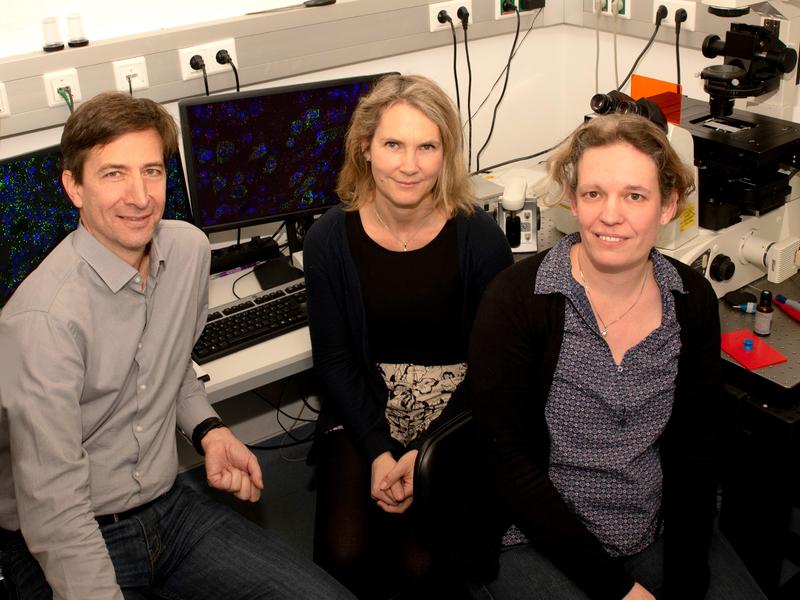

Research the causes of epilepsies (from left): Prof. Dr. Dirk Dietrich, Prof. Dr. Susanne Schoch and Dr. Karen van Loo from the Institute of Neuropathology at the University Bonn Medical Center.
(c) Photo: Katharina Wislsperger/UKB
During an epileptic seizure, the nerve cells fire simultaneously in a very fast rhythm – like a thunderstorm in the brain. This results in seizures. Due to changes in the brain, such a short seizure can develop into chronic epilepsy in the long term.
“The search for new therapies is above all about preventing the gradual development of such severe types of seizures,” says Prof. Dr. Albert J. Becker from the Institute of Neuropathology at the University Hospital Bonn (UKB).
When an epileptic seizure occurs, genes and their regulation are also involved. Genes are blueprints of DNA. Transcripts are made of genes during transcription; these then reach different locations in the nerve cells and influence their function.
As the scientists at the University of Bonn were able to demonstrate several years ago, the transcription factor Early growth response 1 (Egr1) upregulates the calcium channels in the nerve cells. Calcium can then increasingly flow into the pores of the nerve cell channels. This causes them to start firing in unison – an epileptic seizure begins.
Search for epilepsy genes
“However, as we have now discovered, the process is much more complex,” says Dr. Karen M. J. van Loo, junior research group leader at the UKB. “There are other factors involved.” Like in a grid search, the scientist and her UKB colleagues Prof. Dr. Dirk Dietrich from Neurosurgery and Prof. Dr. Sandra Blaess from the Institute of Reconstructive Neurobiology used bioinformatic methods to search for additional epilepsy genes involved in the seizures.
The researchers then observed the interaction of the epileptic factors in human tissue obtained during surgical removal of epileptic foci from patients' brains and in mice.
The main focus is on the triangular relationship of the already known transcription factor Egr1 and the specialized calcium channel pores Cav3.2 and α2δ4 (alpha2delta4). Van Loo: “Especially the role of α2δ4 has been underestimated so far.” By upregulating the transcription factor in mice, the scientists ensured that their nerve cells produced considerably more α2δ4 in the brain.
“The more α2δ4 was present, the greater the tendency to have seizures,” summarizes Prof. Dr. Susanne Schoch-McGovern from the Institute of Neuropathology at the University Hospital Bonn. This connection was also confirmed by investigations using human brain tissue.
Like the anti-lock brake system in a car
The nerve cells in the brain normally protect themselves from an epileptic seizure with a stable rhythm. “This can be compared to the anti-lock braking system in a car, which also protects against overreaction,” says Becker.
Various sensors measure whether a wheel is blocked and then use this information to perform an optimized adjustment of the vehicle’s braking force. If α2δ4 is upregulated, the anti-lock braking system in the nerve cell network figuratively fails and the accelerator pedal is fully depressed: The usual nerve cell rhythm gets out of sync and accelerates – an epileptic seizure is imminent.
“It is not enough to look at individual molecules in the brain to understand the onset of an epileptic seizure,” says Karen van Loo. “Rather, the whole network must be considered.” The scientists regard the calcium channel pores α2δ4 and Cav3.2 in combination with the transcription factor Egr1 to be a promising therapeutic approach to potentially inhibiting the onset of epilepsies. “But intensive research is still required,” emphasizes Susanne Schoch-McGovern.
The study was funded by the German Research Foundation (DFG) within the framework of the Collaborative Research Center SFB 1089 and the Research Group 2715.
Prof. Dr. Albert J. Becker
Institute of Neuropathology
University of Bonn Medical Center
Tel. +49(0)228/28711352
E-mail: Albert_Becker@uni-bonn.de
Karen M.J. van Loo, Christine K. Rummel, Julika Pitsch, Johannes Alexander Müller, Arthur F. Bikbaev, Erick Martinez-Chavez, Sandra Blaess, Dirk Dietrich, Martin Heine, Albert J. Becker, Susanne Schoch: Calcium channel subunit α2δ4 is regulated by early growth response 1 and facilitates epileptogenesis, “The Journal of Neuroscience”, DOI: https://doi.org/10.1523/JNEUROSCI.1731-18.2019












